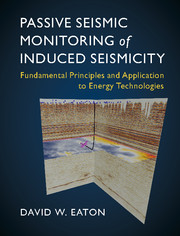 Passive Seismic Monitoring of Induced Seismicity
Passive Seismic Monitoring of Induced Seismicity from Part II - Applications of Passive Seismic Monitoring
Published online by Cambridge University Press: 07 June 2018
Logarithmic plots are a device of the devil.
Charles F. Richter (Earthquake Information Bulletin, 1980)The term induced seismicity, as used in this book, refers to earthquakes or other seismic events that have a clear anthropogenic association. Human activities with the potential to produce appreciable seismic activity include: underground mining (Gibowicz and Kijko, 1994) and construction of tunnels (Husen et al., 2013); impoundment of surface water reservoirs (Simpson et al., 1988); development of engineered geothermal systems (Breede et al., 2013); detonation of underground explosions (Massé, 1981); and, subsurface fluid injection or withdrawal (National Research Council, 2013). Among these different causal mechanisms for induced seismicity, this chapter focuses on injection-induced seismicity from energy technologies, including deep-subsurface saltwater disposal (SWD), hydraulic fracturing (HF) of low-permeability unconventional reservoirs and engineered (or enhanced) geothermal systems (EGS). These three causal mechanisms of induced seismicity occur in different settings and arise from distinct industrial applications, yet they share broadly similar underlying physical mechanisms.
The material in this chapter builds upon previous sections of the book, especially the fundamental theory discussed in the first four chapters. The chapter begins with a review of basic concepts, commencing with definitions for a few key terms. Pioneering work on injection-induced seismicity is then considered, which frames our current understanding of this phenomenon, including criteria for discriminating between induced and natural events. A fluid/stress systems approach is then used to explore necessary conditions for induced seismicity, such as nucleation of dynamic slip on a fault. Seismological tools of the trade that are employed for observations of induced seismicity are then covered, followed by a case histories for various causal mechanisms of deep saltwater disposal, hydraulic fracturing and geothermal applications. Finally, methods used for risk assessment and hazard mitigation are presented, along with a brief discussion of important societal factors.
Background
We set the stage for this chapter by considering several important semantic issues. First, some investigators reserve the adjective “induced” for seismicity caused by human activities that lead to shear stress preturbations on a fault that are comparable in magnitude to the shear stress from the ambient (unperturbed) stress field (McGarr et al., 2002).
To save this book to your Kindle, first ensure no-reply@cambridge.org is added to your Approved Personal Document E-mail List under your Personal Document Settings on the Manage Your Content and Devices page of your Amazon account. Then enter the ‘name’ part of your Kindle email address below. Find out more about saving to your Kindle.
Note you can select to save to either the @free.kindle.com or @kindle.com variations. ‘@free.kindle.com’ emails are free but can only be saved to your device when it is connected to wi-fi. ‘@kindle.com’ emails can be delivered even when you are not connected to wi-fi, but note that service fees apply.
Find out more about the Kindle Personal Document Service.
To save content items to your account, please confirm that you agree to abide by our usage policies. If this is the first time you use this feature, you will be asked to authorise Cambridge Core to connect with your account. Find out more about saving content to Dropbox.
To save content items to your account, please confirm that you agree to abide by our usage policies. If this is the first time you use this feature, you will be asked to authorise Cambridge Core to connect with your account. Find out more about saving content to Google Drive.